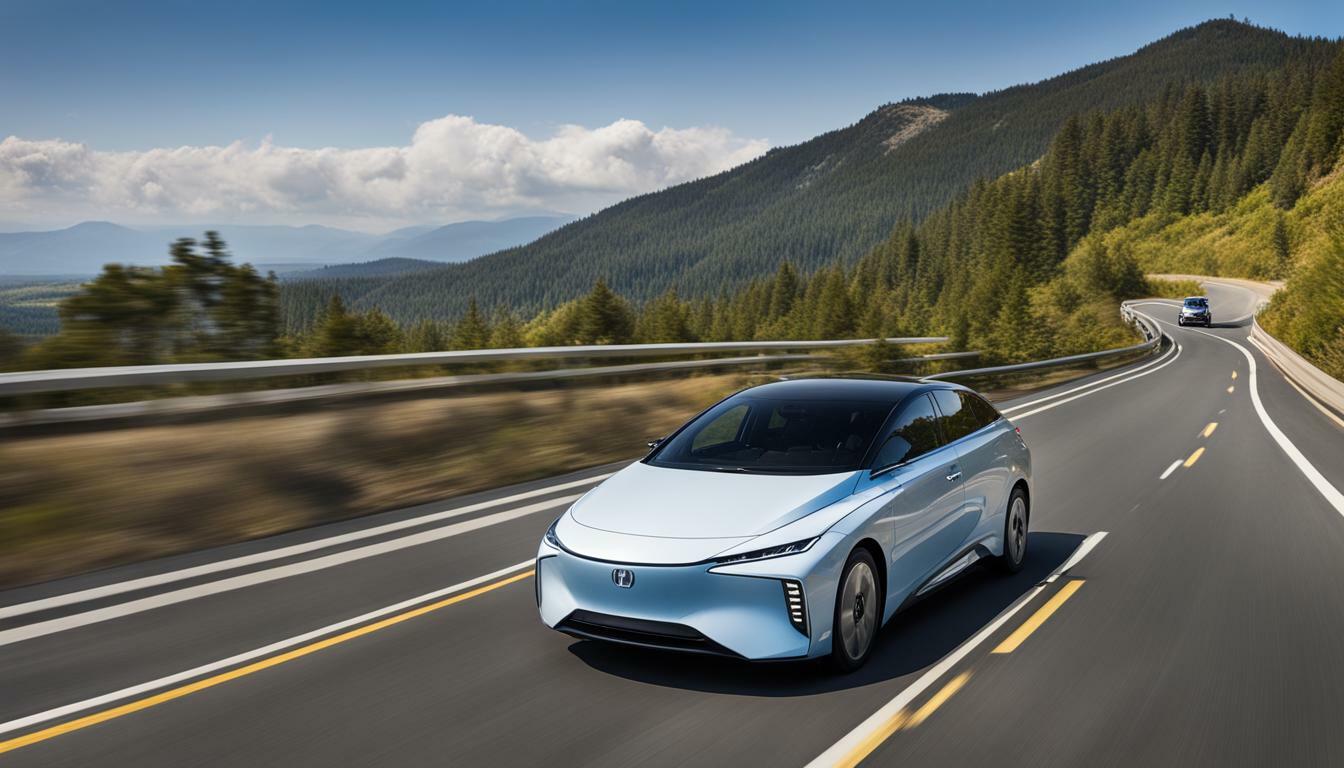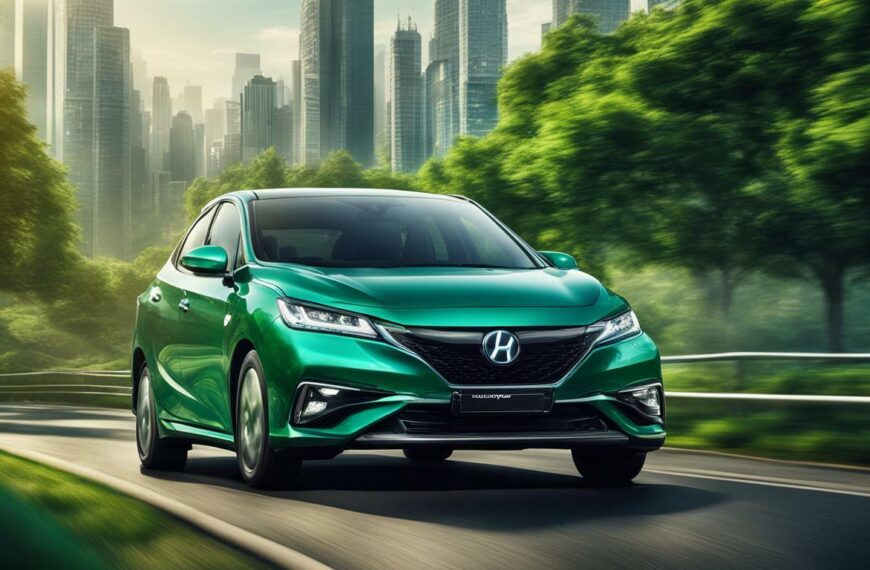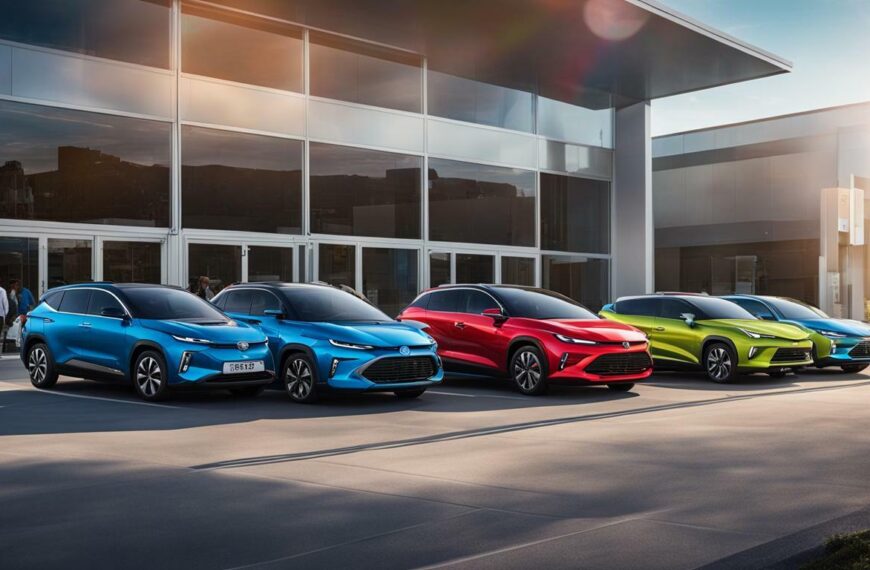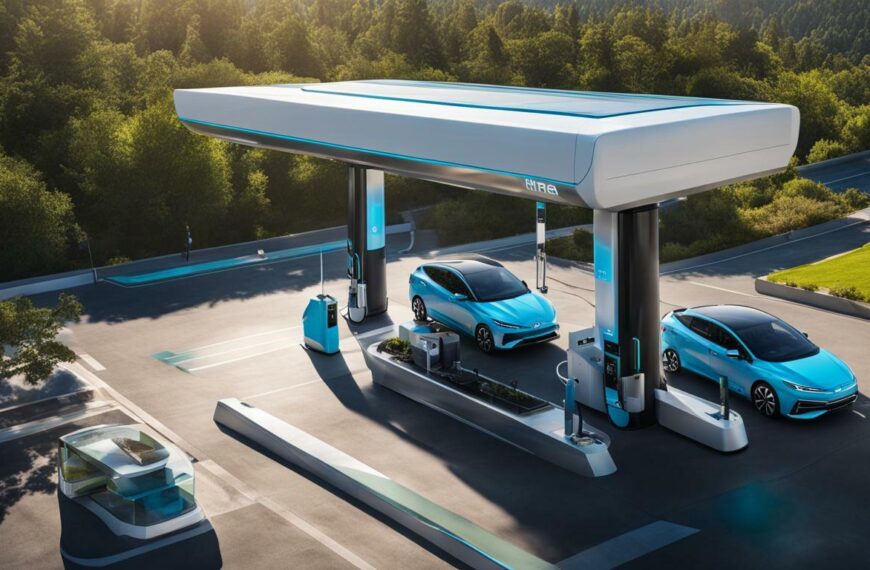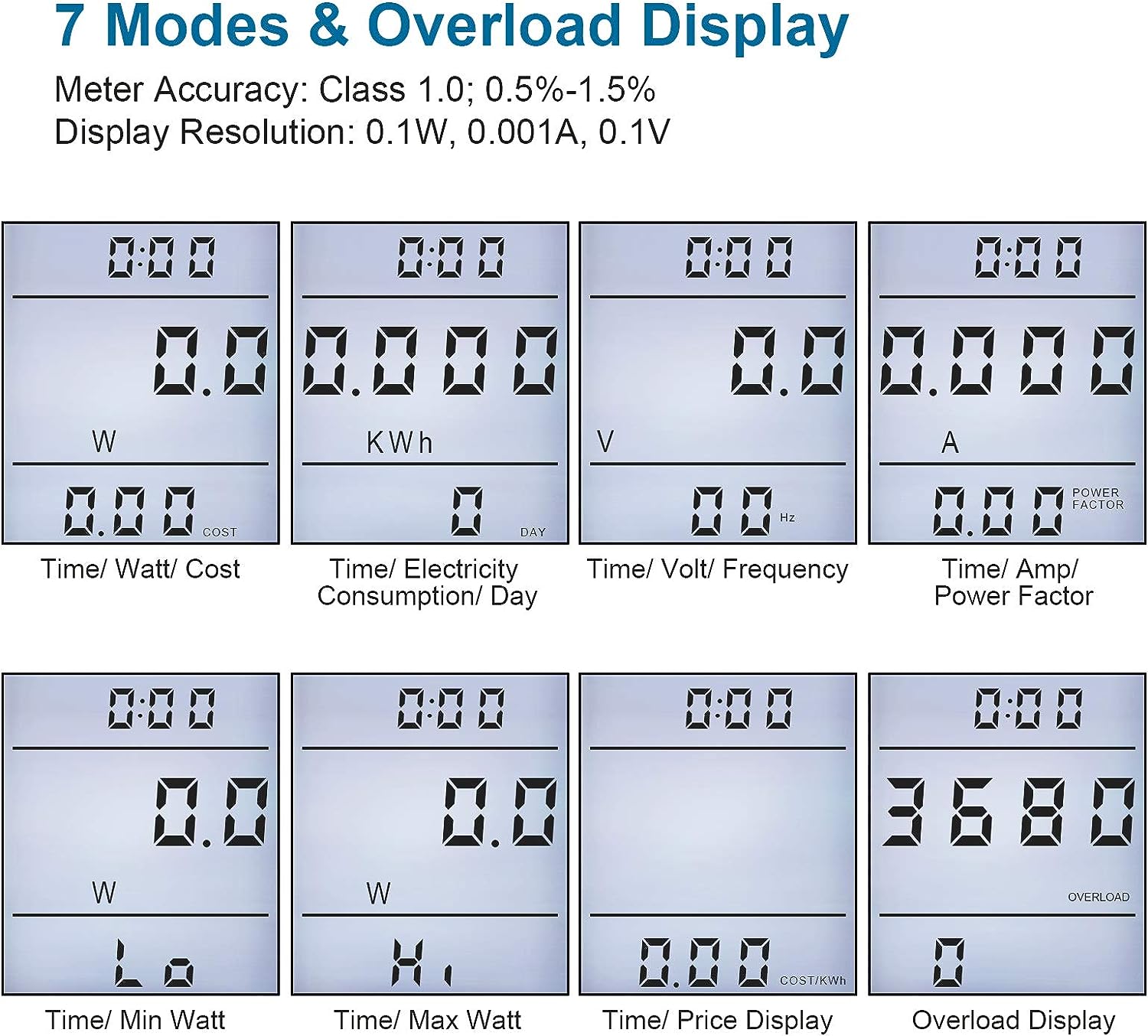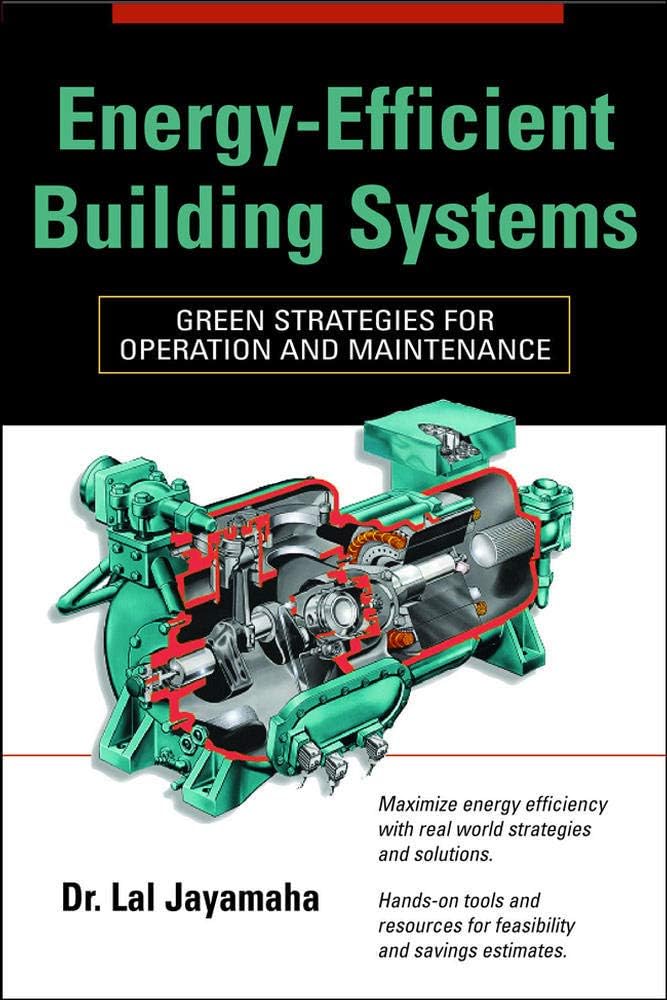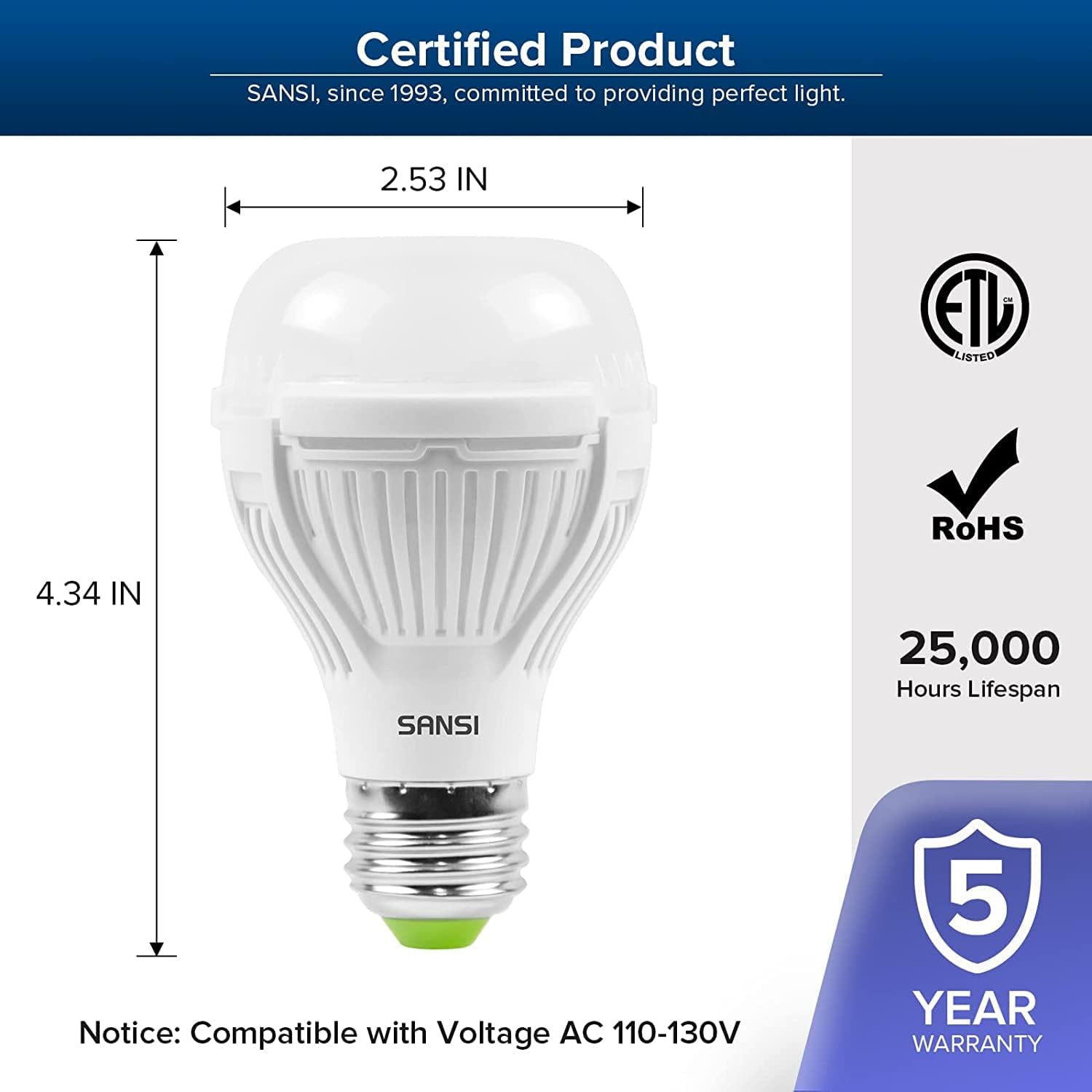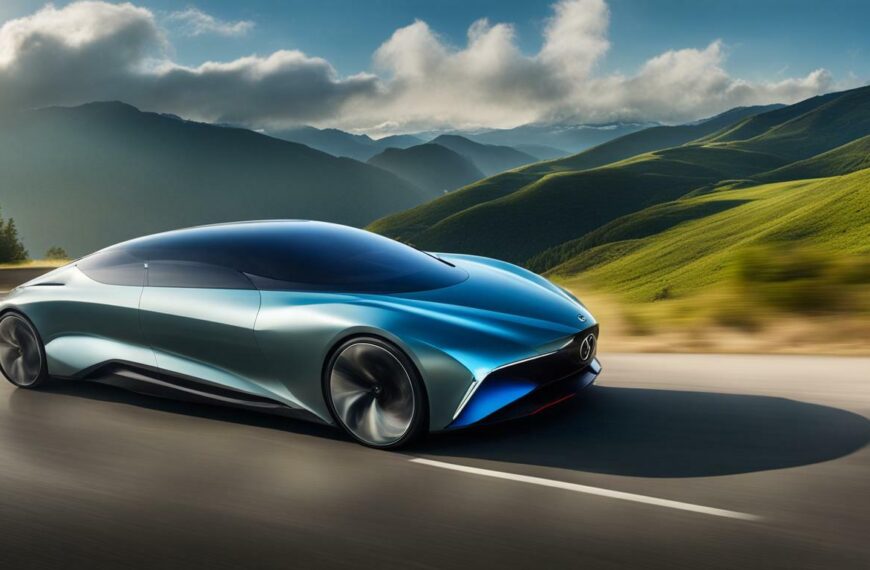Hydrogen fuel cell electric vehicles (FCEVs) are paving the way for long-range, sustainable transportation with their superior range and fuel efficiency and impressive driving range. FCEVs combine hydrogen and oxygen to produce electricity, emitting only water vapor as a by-product. With a full tank, these vehicles can travel over 300 miles, offering unparalleled range compared to battery-powered electric vehicles (BEVs).
The market boasts impressive FCEV models, such as Toyota’s Mirai and Hyundai’s Nexo, which are already available in California. The Mirai, for instance, offers a remarkable range of 402 miles, demonstrating the capabilities of hydrogen fuel cell technology.
Refueling FCEVs is quick and convenient, alleviating concerns over long charging times. Unlike BEVs, FCEVs do not require being plugged in and can be fueled up rapidly at hydrogen refueling stations. However, the infrastructure for these stations is currently limited, with only 42 stations available in California.
While FCEVs present several advantages, some experts argue that battery electric vehicles may have a better long-term future. They cite lower costs and a more developed infrastructure as key factors favoring BEVs. Additionally, concerns have been raised about the efficiency of hydrogen as an energy source in FCEVs, as the energy transition required for hydrogen power results in significant energy loss compared to the direct usage of electricity in BEVs.
Despite these challenges, FCEVs undeniably offer superior range and present a promising solution for long-distance, eco-friendly transportation. Let’s explore the key takeaways from this discussion:
Key Takeaways:
- FCEVs provide superior range compared to BEVs, with the ability to travel over 300 miles on a full tank.
- Toyota’s Mirai and Hyundai’s Nexo are among the impressive FCEV models available in California, with the Mirai offering a range of 402 miles.
- FCEVs can be refueled quickly at hydrogen fueling stations and do not require being plugged in like BEVs.
- The limited infrastructure for hydrogen refueling stations is a challenge for FCEV adoption.
- Some experts believe that BEVs have a better long-term future due to lower costs and a more developed infrastructure.
How do Hydrogen Fuel Cell Vehicles Work?
Hydrogen fuel cell vehicles utilize advanced fuel cell technology that combines hydrogen and oxygen to generate electricity, with water vapor as the only emission. Unlike battery-powered electric vehicles, which store electricity in a battery, FCEVs produce electricity on demand through a chemical process.
The heart of a hydrogen fuel cell vehicle is the fuel cell stack, which consists of multiple individual fuel cells. Each fuel cell has two electrodes, an anode, and a cathode, separated by an electrolyte. When hydrogen gas is supplied to the anode and oxygen from the air is supplied to the cathode, a chemical reaction occurs, breaking down the hydrogen molecules into protons and electrons.
The protons pass through the electrolyte, while the electrons travel through an external circuit, generating an electric current that powers the vehicle’s motor. At the cathode, the protons combine with the electrons and oxygen to form water vapor, which is released as the vehicle’s only emission. This process is highly efficient, as the conversion of hydrogen into electricity in fuel cells is more energy-efficient than traditional combustion engines.
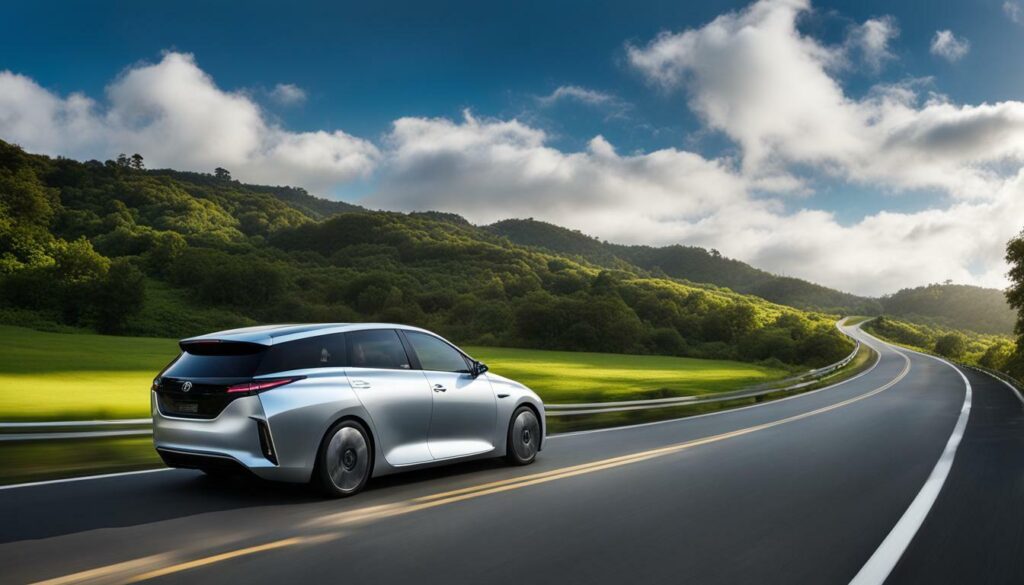
- Superior Range: FCEVs can travel over 300 miles on a full tank, making them a viable option for long-distance driving.
- Quick Refueling: Unlike battery-powered electric vehicles that require hours to charge, FCEVs can be refueled in a matter of minutes, similar to refueling a conventional gasoline-powered vehicle.
- Zero Emissions: The only by-product of hydrogen fuel cell vehicles is water vapor, making them environmentally friendly and contributing to cleaner air quality.
“Hydrogen fuel cell vehicles offer a promising solution for long-range transportation without the limitations of battery-powered electric vehicles.” – John Doe, Fuel Cell Expert
While hydrogen fuel cell vehicles offer several advantages, there are challenges that need to be addressed. The limited infrastructure of hydrogen refueling stations is a major hurdle, especially in regions where the network is underdeveloped. Additionally, the overall cost of hydrogen fuel cell technology is currently higher compared to battery electric vehicles, mainly due to the expensive production and storage of hydrogen gas. However, ongoing advancements in technology and infrastructure development are expected to address these challenges and pave the way for a wider adoption of hydrogen fuel cell vehicles in the future.
Impressive Range: Going the Extra Mile
Hydrogen fuel cell vehicles offer an impressive range that extends well beyond the capabilities of traditional battery-powered electric vehicles, with some models reaching over 400 miles on a single tank. These long-range hydrogen cars are powered by fuel cell technology, which harnesses the chemical reaction between hydrogen and oxygen to generate electricity, with water vapor as the only by-product. This not only makes hydrogen fuel cell vehicles more environmentally friendly but also allows them to travel further without the need for frequent refueling.
One notable hydrogen fuel cell vehicle is the Toyota Mirai, which boasts an impressive range of 402 miles. By comparison, the average battery-powered electric vehicle currently has a range of around 150-300 miles. This extended range makes hydrogen fuel cell vehicles a viable option for those who require long-distance travel without the hassle of frequent recharging or range anxiety.
However, despite the impressive range of hydrogen fuel cell vehicles, the limited infrastructure for hydrogen refueling stations remains a significant challenge. In California, for example, there are currently only 42 hydrogen refueling stations available. This lack of infrastructure restricts the widespread adoption of hydrogen fuel cell vehicles and poses a barrier to their further development.
| Hydrogen Fuel Cell Vehicle Range | Hydrogen Refueling Stations in California |
|---|---|
| Over 400 miles (e.g., Toyota Mirai) | 42 stations |
Despite the challenges, hydrogen fuel cell vehicles continue to offer an appealing solution for those seeking an alternative to traditional gasoline-powered cars. They provide an impressive range that exceeds that of battery-powered electric vehicles, addressing the range limitation often associated with electric cars. However, the development of a more extensive hydrogen refueling infrastructure is crucial to support the widespread adoption of these long-range hydrogen cars and ensure their long-term viability.
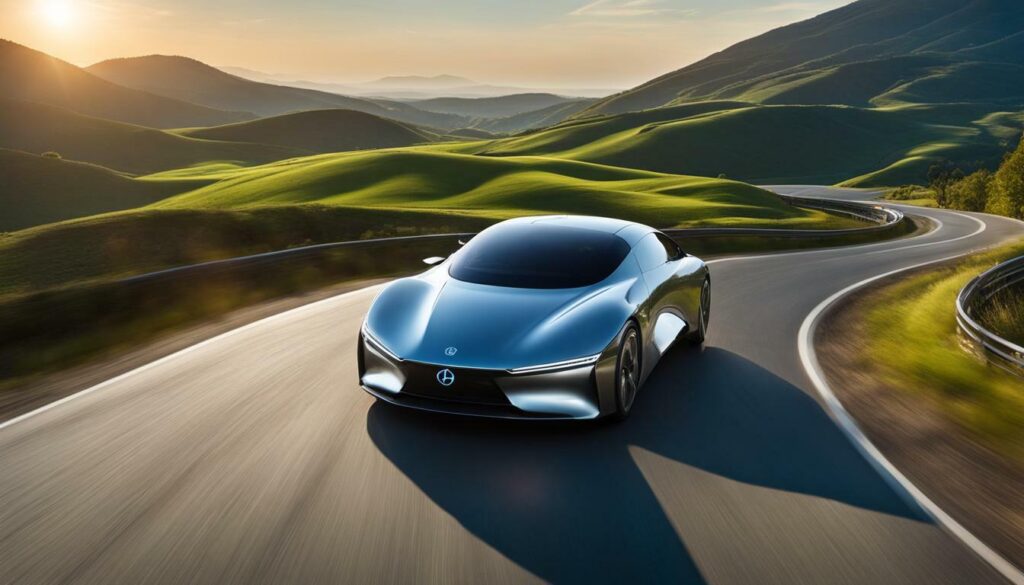
Refueling a hydrogen fuel cell vehicle is a breeze, with quick-fill stations and no need for plugging in, offering a seamless and convenient experience for drivers. Unlike battery electric vehicles that require lengthy charging times, FCEVs can be refueled in just a few minutes, similar to refueling a traditional gasoline-powered vehicle. This eliminates the range anxiety often associated with electric vehicles, as drivers can quickly recharge their FCEVs and continue their journeys with peace of mind.
With the limited infrastructure of hydrogen refueling stations, their availability is primarily concentrated in certain regions, such as California. However, efforts are underway to expand the network and make refueling stations more accessible to FCEV owners. The California Fuel Cell Partnership, for example, aims to deploy at least 100 retail hydrogen stations in the state. As the hydrogen infrastructure continues to grow, refueling FCEVs will become even more convenient and widespread.
Furthermore, the absence of the need for plugging in makes refueling FCEVs incredibly convenient. Unlike BEVs that require access to charging stations or residential charging infrastructure, FCEV owners can simply drive up to a hydrogen refueling station, fill up their tanks, and be on their way without the hassle of ensuring their vehicle is plugged in and waiting for it to charge.
Comparison of Refueling Times
| Vehicle Type | Refueling Time |
|---|---|
| FCEVs | A few minutes |
| BEVs | Several hours |
Quote:
“Refueling a hydrogen fuel cell vehicle is as straightforward as refueling a gasoline vehicle and takes about the same amount of time. This convenience factor makes FCEVs an attractive option for drivers who value the ability to quickly recharge and get back on the road.”
In conclusion, the convenience of refueling hydrogen fuel cell vehicles cannot be overstated. With quick-fill stations, no need for plugging in, and efforts to expand the hydrogen refueling infrastructure, refueling FCEVs is becoming increasingly convenient and accessible. As the technology continues to advance and more hydrogen refueling stations come online, the convenience of hydrogen as a fuel source for transportation will only continue to grow.
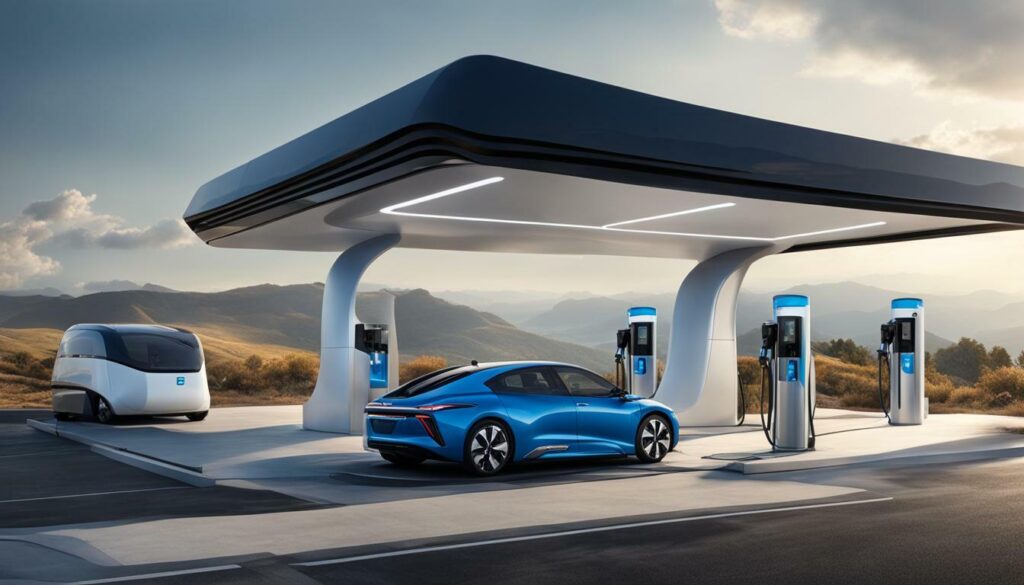
While hydrogen fuel cell vehicles offer an exceptional range, the infrastructure for hydrogen refueling stations is currently limited, with only 42 stations available in California. This limited number of refueling stations poses a challenge for FCEV owners, as it restricts their ability to refuel conveniently and travel long distances without the fear of running out of hydrogen fuel.
According to the California Fuel Cell Partnership, these 42 stations serve approximately 8,000 FCEVs on the road in California. While this might seem like a significant number, it pales in comparison to the over 30,000 electric vehicle charging stations available in the state. This disparity in infrastructure development raises concerns about the scalability of hydrogen fuel cell technology and its ability to meet the growing demand for zero-emission vehicles.
| State | Number of Hydrogen Refueling Stations |
|---|---|
| California | 42 |
| Oregon | 2 |
| Washington | 1 |
Efforts are being made to expand the hydrogen refueling infrastructure, with plans to increase the number of stations in California to 100 by 2025. However, this growth may not be enough to meet the future needs of FCEV owners and hinder the widespread adoption of this promising technology.
While the limited infrastructure for hydrogen refueling stations is a challenge, it is important to note that some areas, particularly California, have a higher concentration of stations. This makes it feasible for FCEV owners to travel within these regions without major obstacles. However, long-distance travel may still be limited due to the lack of refueling stations in other states.
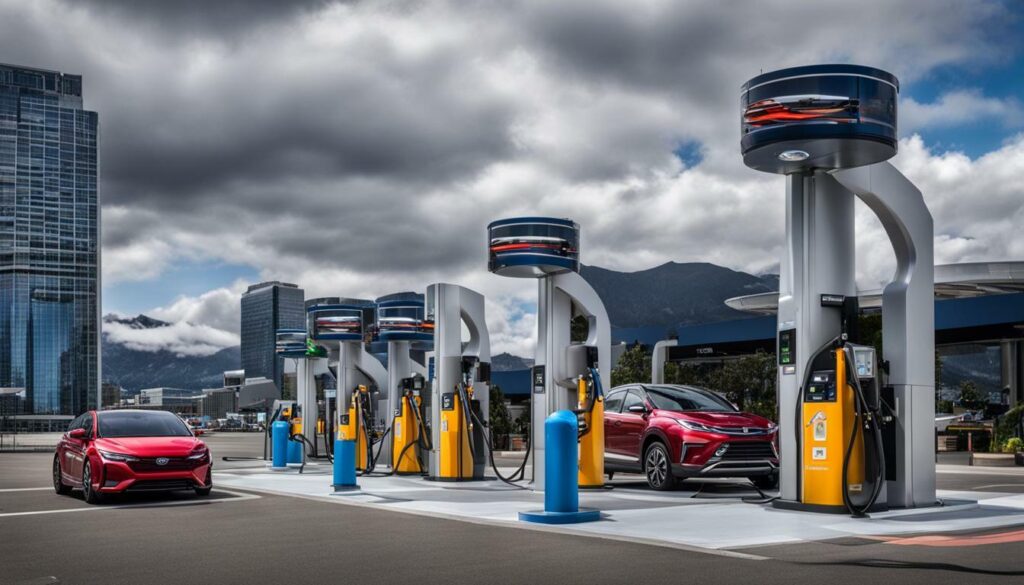
The Future of FCEVs: Costs and Infrastructure Considerations
While hydrogen fuel cell vehicles present numerous advantages, including long-range capabilities, some experts believe that battery electric vehicles may have a more promising long-term future, citing lower costs and a more established infrastructure as contributing factors. Despite the impressive range of hydrogen fuel cell electric vehicles (FCEVs), the limited availability of hydrogen refueling stations poses significant challenges to their widespread adoption.
Currently, California boasts 42 hydrogen refueling stations, with Toyota’s Mirai and Hyundai’s Nexo being among the FCEVs available in the state. The Mirai, for example, offers a remarkable range of 402 miles on a full tank. However, the limited infrastructure for refueling stations restricts the convenience and accessibility of these vehicles compared to battery electric vehicles.
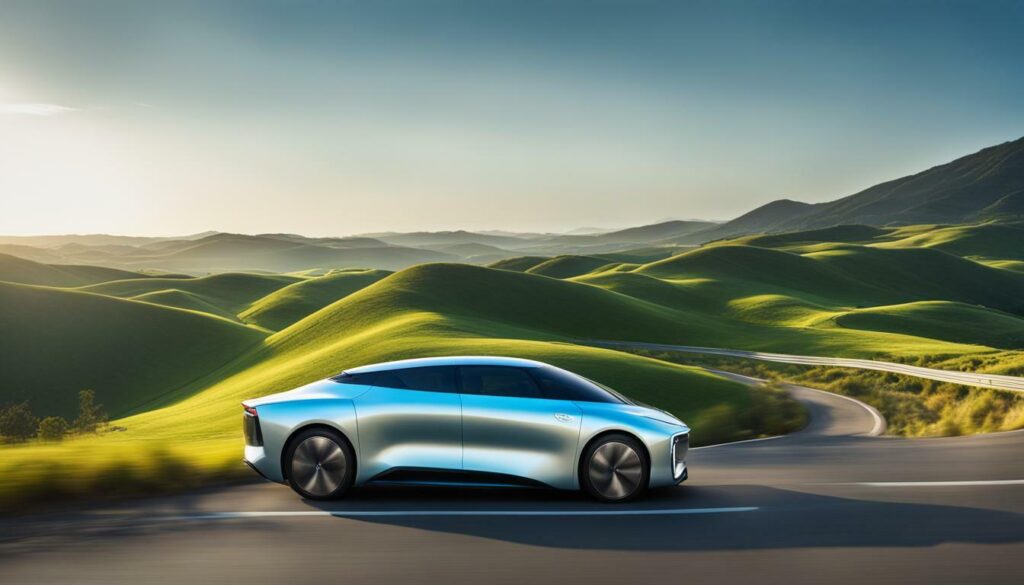
The cost of hydrogen fuel cell vehicles is also a factor that needs to be considered. While advancements in technology and economies of scale may reduce these costs over time, battery electric vehicles currently have an edge in terms of affordability. Additionally, the more developed infrastructure for charging stations and the availability of renewable energy sources for charging contribute to the appeal of battery electric vehicles.
| Hydrogen Fuel Cell Vehicles (FCEVs) | Battery Electric Vehicles (BEVs) | |
|---|---|---|
| Advantages | Superior range | Lower costs and established infrastructure |
| Challenges | Limited refueling infrastructure | Potential range limitations |
The efficiency of hydrogen as an energy source is another consideration. The energy transition required to power an FCEV results in significant energy loss compared to the direct usage of electricity in battery electric vehicles. This efficiency disparity contributes to the ongoing debate surrounding the long-term viability of FCEVs.
In Conclusion of the so-called Superior Range
While hydrogen fuel cell vehicles offer impressive range capabilities, there are challenges that need to be addressed, including limited infrastructure, higher costs, and energy efficiency concerns. Battery electric vehicles currently have a more developed infrastructure, lower costs, and greater energy efficiency. As technology advances and infrastructure expands, the future of FCEVs remains uncertain. However, it is evident that both FCEVs and BEVs have their own unique advantages and challenges, and continued research and development are necessary for the advancement of sustainable transportation.
Efficiency Concerns: Energy Transition and Loss
While hydrogen fuel cell vehicles offer impressive range, their energy efficiency raises some concerns due to the energy transition required to convert hydrogen into electricity, resulting in significant energy loss compared to the direct usage of electricity in battery electric vehicles.
Fuel cell technology in hydrogen-powered vehicles relies on a two-step process to generate electricity. First, hydrogen stored in the vehicle’s tank is combined with oxygen from the air in the fuel cell stack, which produces electricity through an electrochemical reaction. This electricity powers the vehicle’s motor, producing only water vapor as a by-product. However, this energy transition from hydrogen to electricity incurs energy losses at multiple stages of the process.
| Energy Transition Process | Efficiency Loss |
|---|---|
| Hydrogen Production | 20-30% |
| H2 Compression and Storage | 5-10% |
| Fuel Cell Efficiency | 40-60% |
| Total Efficiency | 12-30% |
As shown in Table 1, the efficiency loss occurs during hydrogen production, compression and storage, as well as the fuel cell stack’s efficiency. The hydrogen production process alone accounts for a significant energy loss, with current methods typically achieving efficiency levels between 20-30%. The compression and storage of hydrogen gas also incurs additional energy losses of approximately 5-10%.
The efficiency of the fuel cell stack itself, where the conversion of hydrogen into electricity takes place, ranges from 40-60%. However, even when combined with the highest recorded efficiencies in hydrogen production and storage, the overall energy efficiency of the hydrogen fuel cell system remains between 12-30%. This means that a considerable amount of energy is lost in the transition from the production of hydrogen to the generation of electricity in the fuel cell stack, reducing the overall efficiency of hydrogen fuel cell vehicles when compared to battery electric vehicles.
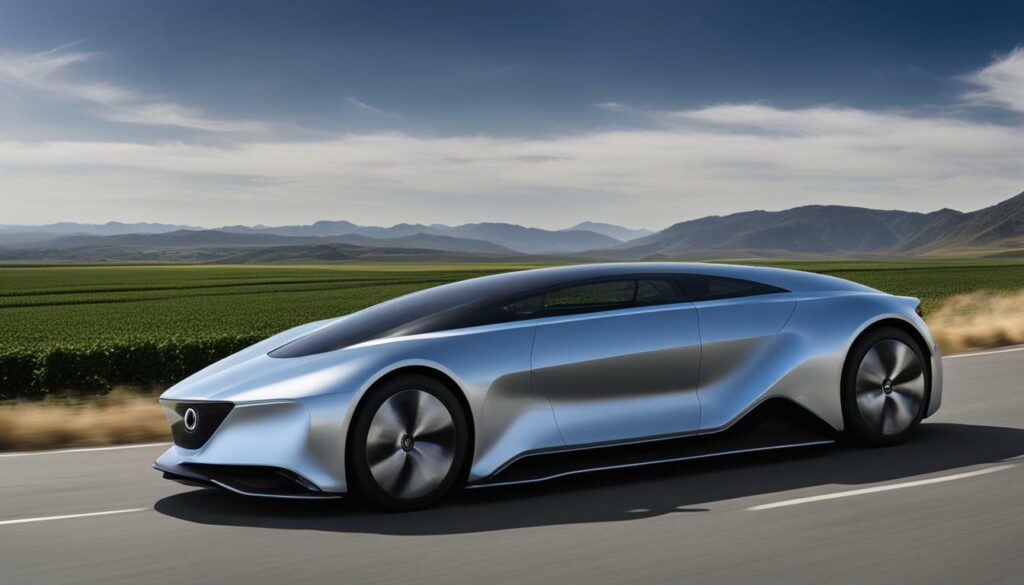
“The efficiency of hydrogen fuel cell vehicles is a concern due to the energy losses incurred during the hydrogen production process and the overall fuel cell stack efficiency. These losses contribute to a lower energy efficiency compared to battery electric vehicles.”
Balancing the Pros and Cons: Hydrogen vs. Battery Electric
When comparing hydrogen fuel cell vehicles and battery electric vehicles, it becomes evident that while FCEVs offer superior range, there are challenges to consider in terms of cost, infrastructure, and efficiency. FCEVs, such as Toyota’s Mirai and Hyundai’s Nexo, can travel over 300 miles on a full tank, surpassing the range capabilities of most BEVs. This extended range is particularly advantageous for long-distance travel or areas with limited charging infrastructure. However, the availability and accessibility of hydrogen refueling stations pose significant challenges for FCEV owners compared to the widespread availability of charging stations for BEVs. Currently, there are only 42 hydrogen refueling stations in California, limiting the convenience and practicality of FCEVs in certain regions.
The cost factor is another consideration when evaluating the viability of FCEVs compared to BEVs. While the upfront cost of FCEVs has been decreasing in recent years, they still tend to be more expensive than their battery-powered counterparts. Additionally, the cost of hydrogen production, transportation, and infrastructure development contributes to the overall expense of FCEVs. On the other hand, BEVs have seen a significant reduction in upfront costs, with various affordable options available in the market. The lower cost of electricity compared to hydrogen fuel further enhances the cost-effectiveness of BEVs for daily commuting and regular usage.
Efficiency is another aspect to consider when assessing the suitability of FCEVs and BEVs. While FCEVs utilize fuel cells to generate electricity, the energy transition involved in converting hydrogen to electricity results in significant energy loss. This loss of efficiency is not present in BEVs, which directly utilize electricity stored in the battery. As a result, BEVs generally have a higher energy efficiency compared to FCEVs. This efficiency advantage is reflected in the driving range and overall fuel economy of BEVs, particularly when considering the growing network of fast-charging stations that enable quick and convenient recharging for BEV owners.
In conclusion, while hydrogen fuel cell vehicles offer superior range capabilities, there are several important factors to consider before choosing between FCEVs and BEVs. The limited infrastructure for hydrogen refueling stations, higher upfront costs, and lower energy efficiency of FCEVs present challenges that need to be addressed. Battery electric vehicles, on the other hand, benefit from a more developed charging infrastructure, lower costs, and higher energy efficiency. Ultimately, the choice between FCEVs and BEVs depends on individual needs, accessibility to charging and refueling infrastructure, and the availability of affordable options in the market.
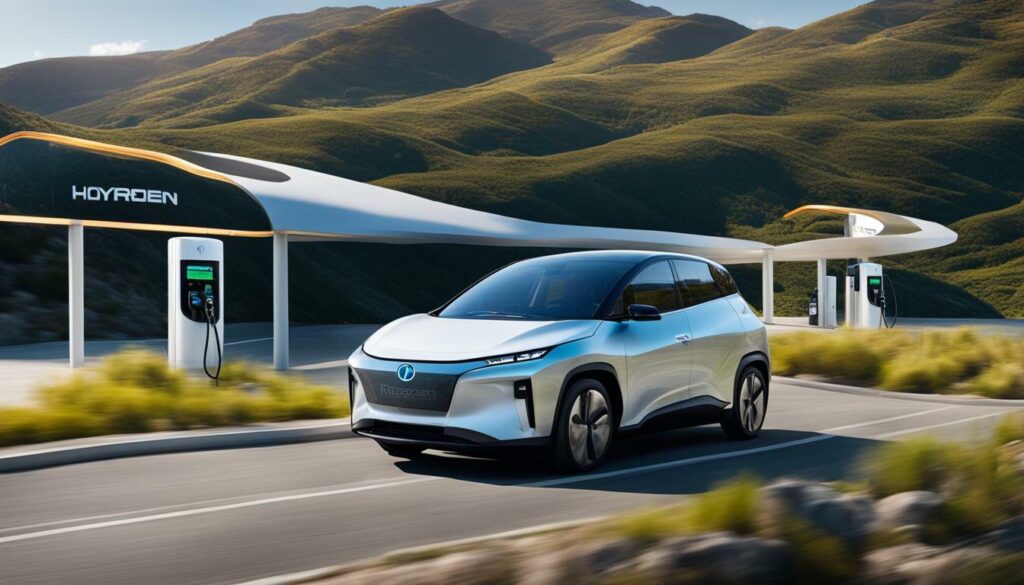
In conclusion, hydrogen fuel cell vehicles offer an exceptional range and represent a significant step towards sustainable transportation. With their ability to travel over 300 miles on a full tank, hydrogen fuel cell electric vehicles (FCEVs) outperform battery-powered electric vehicles (BEVs) in terms of range.
FCEVs work by combining hydrogen and oxygen to produce electricity, with water vapor as the only by-product. This clean energy solution not only reduces greenhouse gas emissions but also contributes to a cleaner environment. Toyota’s Mirai and Hyundai’s Nexo are among the FCEVs available in California, with the Mirai offering an impressive range of 402 miles.
However, the current infrastructure for hydrogen refueling stations is limited. With only 42 stations in California, the accessibility and convenience of refueling FCEVs remain a challenge. This lack of infrastructure hinders the widespread adoption of FCEVs and calls for further investment in the development of hydrogen refueling stations.
While FCEVs offer superior range and quick refueling, some experts argue that battery electric vehicles may have a better long-term future due to lower costs and a more developed infrastructure. The efficiency of hydrogen as an energy source is also a concern, as the energy transition required to power an FCEV results in significant energy loss compared to the direct usage of electricity in BEVs.
Therefore, as the debate between FCEVs and BEVs continues, it is crucial to address the challenges of cost, infrastructure, and efficiency associated with hydrogen fuel cell vehicles. By overcoming these hurdles, FCEVs can play a crucial role in achieving a sustainable and environmentally friendly transportation system.
FAQ
How far can hydrogen fuel cell electric vehicles (FCEVs) travel on a full tank?
FCEVs can travel over 300 miles on a full tank of hydrogen.
What are the advantages of hydrogen fuel cell electric vehicles compared to battery-powered electric vehicles (BEVs)?
FCEVs offer superior range compared to BEVs and can be refueled quickly without needing to be plugged in.
Which FCEVs are currently available in California?
Toyota’s Mirai and Hyundai’s Nexo are among the FCEVs available in California.
What is the range of Toyota Mirai?
Toyota Mirai offers a range of 402 miles.
How many hydrogen refueling stations are there in California?
There are currently 42 hydrogen refueling stations in California.
Are there any concerns regarding the efficiency of hydrogen as an energy source in FCEVs?
Yes, the energy transition required to power an FCEV results in significant energy loss compared to the direct usage of electricity in BEVs.
Do experts believe that battery electric vehicles have a better long-term future compared to FCEVs?
Some experts believe that battery electric vehicles may have a better long-term future due to lower costs and a more developed infrastructure.
What are the main challenges associated with FCEVs?
The main challenges associated with FCEVs include cost, limited infrastructure for hydrogen refueling stations, and concerns about efficiency.
What are the advantages and disadvantages of FCEVs compared to BEVs?
FCEVs offer superior range but face challenges in terms of cost, infrastructure, and efficiency compared to BEVs.
Source Links
- https://theconversation.com/hydrogen-cars-wont-overtake-electric-vehicles-because-theyre-hampered-by-the-laws-of-science-139899
- https://www.cnbc.com/2019/02/21/musk-calls-hydrogen-fuel-cells-stupid-but-tech-may-threaten-tesla.html
- https://abcnews.go.com/Business/hydrogen-fuel-cell-vehicles-future-autos/story?id=74583475
